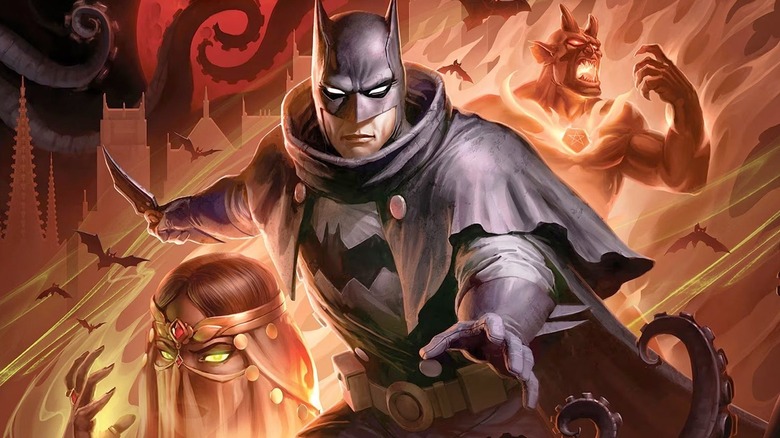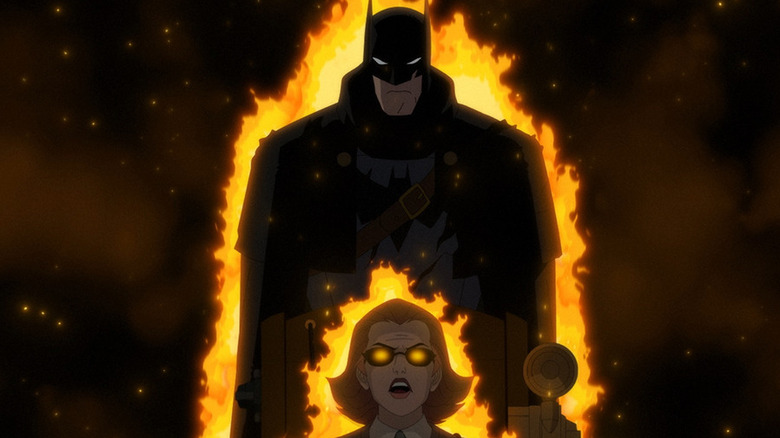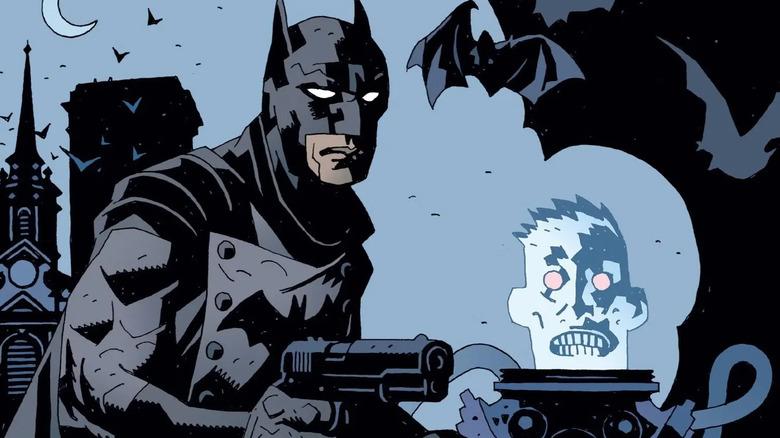An Underrated Batman Movie Is A Love Letter To H.P. Lovecraft's Cosmic Horror
We may receive a commission on purchases made from links.
Batman may be the most grounded of the major superheroes. He has no superpowers, just years of athletic training and cultivating of knowledge. The most acclaimed Batman movies, Christopher Nolan's "Dark Knight" films, were all about adding realism to the legend of Batman, which has definitely affected public perception of and expectations of a Batman film. But that realism can be limiting. Batman is a fantastic pulp adventurer, and ideally, Gotham City should be a place where the impossible can happen.
One Batman movie that dives right into the unrealistic is 2023's "Batman: The Doom That Came to Gotham." Adapted from a 2001 comic mini-series by Mike Mignola, Richard Pace, and Troy Nixey, "The Doom That Came to Gotham" is one of the best animated Batman films ever made. It's an "Elseworlds" tale, which reimagines a DC hero in a different time or genre. Mignola and Brian Augustyn did the first "Elseworlds" story, 1989's "Gotham by Gaslight," that starred a Victorian-era Batman. 12 years later, Mignola returned to turn Batman into an occult detective.
The film is set in the late 1920s. This version of Bruce Wayne (David Giuntoli) has spent 20 years sailing around the world. When he returns to Gotham to finally become Batman, it's not to battle gangsters or costumed criminals, but rather an ancient supernatural evil and those following its will.
"Doom" is animated in the house style of other animated DC films, but it has a few period-accurate flourishes. The film's end credits are rendered in black and white with font right out of a 1930s serial. But the biggest sign of the era is the writer "Doom" most pulls from — not another Batman writer, but H.P. Lovecraft, father of Cthulhu and cosmic horror.
The picture's title riffs on "The Doom That Came to Sarnath," which is about an ancient shining city on a hill that fell into ruin. The film opens with Bruce and company investigating a missing Antarctic expedition, a la Lovecraft's "At The Mountains of Madness." The story's climax is Batman preventing Ra's al Ghul (Navid Negahban) from unleashing a many-angled monstrosity called Iog-Sotha (read: Yog-Sothoth).
Lovecraft's influence on Batman extends beyond only this story. Arkham Asylum, the gothic prison where Batman's foes dwell? That's named after Arkham, Massachusetts, a fictional town in Lovecraft stories. But "The Doom That Came to Gotham" dives even deeper into the occult and unknowable horrors.
How The Doom That Came to Gotham reimagines Batman
"The Doom That Came to Gotham" reimagines Batman's world, so it also reinvents that world's characters to be more like how Lovecraft might've written them in the 1920s. Batman is one of the least changed, down to his mostly familiar costume. The biggest difference is that this Bruce Wayne has no problem using guns, much like The Shadow and other pulp heroes of this era.
Bruce's small army of Robins is reimagined as orphans he recruited to his ship's crew while traveling across the world. They don't get costumes, but they're still Batman's sidekicks. The comic uses the first three Robins (Dick Grayson, Jason Todd, and Tim Drake), but the movie swaps out Tim for Kai-Li Cain (Tati Gabrielle), a renamed take on Cassandra Cain/Batgirl.
Speaking of Batgirl, Barbara Gordon was reinvented as master hacker Oracle after the Joker paralyzed her in "The Killing Joke." In "Doom," Barbara (Gideon Adlon) is an oracle in the magical sense. She communes with Bruce, helping him reach into the afterlife so he can talk to his father Thomas (Darin De Paul) and learn his destiny.
The movie can't fit in all the important Batman villains, but it's not for lack of trying. In "At The Mountains of Madness," one of the terrors the characters encounter are monstrous penguins that make unnatural noises. ("Tekeli-li!") So, in "Doom That Came to Gotham," Oswald Cobblepot (William Saylers) is the leader of the original expedition. He lost his body and sanity to Iog-Sotha and so chooses to live among the similarly mutated penguins.
Cobblepot's crewman Grendon (David Dastmalchian) rises from the dead as a frozen zombie who can spread the cold. No freezing ray in sight, but he's still the analogue to Mr. Freeze. The seed that transformed Grendon sprouts from his body to become a shapeshifting humanoid plant, or Poison Ivy. Ludvig Prinn, a Gothamite mutated into the form of reptiles who once ruled the world, is Killer Croc.
The mastermind villains are Ra's al Ghul and his daughter Talia (Emily O'Brien). Ra's long ago communed with the dark Elder Gods, founding the Cult of Ghul and writing its source material, "The Testament of Ghul." Talia uses the book to resurrect her father, calling him forth like Lazarus. "Doom" leans on the orientalism of the Ghul family, dressing Ra's in a turban and Talia in a badlah. This choice matches the aesthetics of 20th century pulp villains (see: Fu Manchu), but the designs still feel like the story is merely recreating Lovecraft's infamous racism rather than adjusting it.
Some other DC heroes show up in "Doom," too. Oliver Queen (Christopher Gorham) is an old friend of Bruce's. He's not Green Arrow, but thinks it is his responsibility to save Gotham with a quiver of blessed arrows. Jason Blood/Etrigan the Demon (Matthew Waterson) also features as a harbinger of doom, warning Bruce that to save Gotham, he must die ... or must he?
Batman: The Doom That Came to Gotham is based on a comic from the creator of Hellboy
Most Batman stories depict the Wayne family as old money with deep roots in Gotham. In "Doom That Came to Gotham," they truly are old money. Contacting his father's spirit, Bruce learns that Thomas was one of the original settlers of Gotham centuries prior. Thomas and others discovered the Testament of Ghul; they gained agelessness from its power but also made the land into the destined spot for Iog-Sotha.
Bruce's cursed lineage means only he can defeat Ra's and Iog-Sotha — and he does, by giving into his darkness and transforming into a humanoid bat monster. He hasn't changed back at the story's end; he's sleeping in the belltower where he ran after his parents were murdered. In that tower, he saw a swarm of bats, but Bruce is part of that swarm now, waiting in darkness to stop the next doom that may come to Gotham's shores.
"The Doom That Came to Gotham" feels intertwined with Mignola's other comics — not his Batman stories, but his Hellboy ones. H.P. Lovecraft is one of Mignola's biggest influences; the first "Hellboy" mini-series, "Seed of Destruction," includes a dedication to Lovecraft (along with Jack Kirby, Mignola's wife Christine, and "the amazing Elmer Newton"). The history of the "Hellboy" world, with ancient cities and cosmic deities, is similar to the Lovecraft mythos. But when Hellboy comes across horrible monsters, he shrugs it off, unlike Lovecraft protagonists who walk away shaken or mad.
The overarching monsters of the "Hellboy" universe are the Ogdru Jahad, seven elder god dragons whose power rivals Cthulhu. (The Guillermo del Toro "Hellboy" movies gave the Ogdru Jahad squid-like bodies, making them even more like Cthulhu.) Killer Croc's depiction in "Doom That Came to Gotham" is similar to the frog-like spawn of the Jahad.
Mignola writes his Lovecraftian Batman in "Doom" to use guns like Hellboy, and Mignola's Batman-esque vigilante Lobster Johnson. Batman fighting the supernatural can also evoke Mignola's character Sir Edward Grey, or the Witchfinder, a homage to occult detective heroes of the late 19th century. In the "Witchfinder" volume 1 foreword, Mignola writes:
"I have a particular love for the old occult detectives — Van Helsing, of course (though he really wasn't much of a detective), Carnacki, Flaxman Low, Alymer Vance, Francis Chard, John Silence ... I love that they wrangled ghosts and vampires (of course) but I particularly love the time period."
Batman's fate in "Doom That Came to Gotham" is similar to Hellboy's, where they both have destinies to meet at the end of the world and can't outrun that. Spoiler: In the comics, the "Seed of Destruction" is Hellboy himself, because he was summoned to end the world. His journey, and Batman's in "The Doom That Came to Gotham," are about how even a man trapped by circumstance can still make the right choice.
"Batman: The Doom That Came To Gotham" is streaming on Max.


